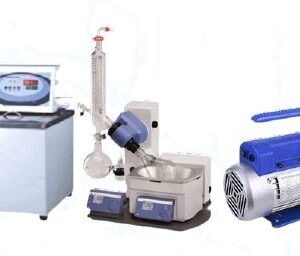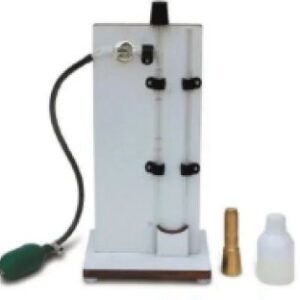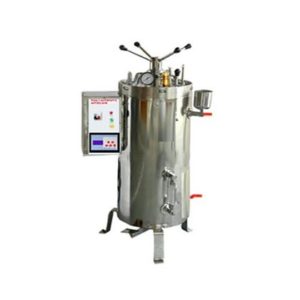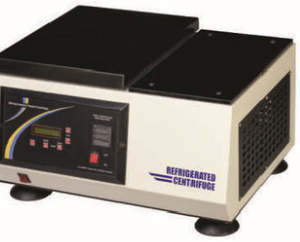REFRIGERATED CENTRIFUGE
Make Dinesh Scientific
DESCRIPTION
With the use of centrifugal force, materials with varying densities can be separated in a sophisticated laboratory device called a chilled centrifuge. It works on the idea that the denser particles in a sample travel outward and form different layers when it is spun rapidly. The following is a thorough explanation of a chilled centrifuge:
MAIN COMPONENTS:
ROTOR: The sample tubes or containers are held in place by the centrifuge’s rotor. It creates centrifugal force by spinning quickly.
MOTOR: The rotor is driven by a strong motor, which enables high rotation rates.
CONTROL PANEL: Users can adjust centrifuge process parameters like speed, temperature, and duration via the control panel.
REFRIGERATION SYSTEM: This feature separates a conventional centrifuge from a chilled one. It has a cooling system that keeps the centrifugation temperature low, which is essential for protecting the integrity of samples that are sensitive to temperature changes.
- 2. FUNCTIONALITY:
CENTRIFUGATION: The main purpose is to rotate the samples quickly such that the denser components settle to the bottom of the tubes.
REFRIGERATION: The centrifuge’s internal temperature is regulated by an integrated refrigeration system, which permits sample separation without jeopardizing the integrity of materials that are sensitive to temperature changes.
3.APPLICATIONS:
CELL SEPARATION: Cells are divided according to density in biological research.
PROTEIN PURIFICATION: vital for separating and purifying proteins from complicated mixtures in biological investigations.
DNA AND RNA EXTRACTION: helps to separate nucleic acids from biological materials more easily.
CLINICAL DIAGNOSTICS: utilized in clinical labs for a range of diagnostic procedures, including the separation of blood components.
TEMPERATURE CONTROL:
- Depending on the model, the refrigeration system can normally regulate the temperature between below ambient and below zero.
SAFETY FEATURES:
- LID LOCKING MECHANISM: Makes sure the centrifuge lid stays firmly closed while it is in use..
AUTOMATIC IMBALANCE DETECTION: In the event of an imbalance, stops the centrifuge to protect the samples and the device.
CAPACITY AND SPEED:
- SAMPLE CAPACITY: To handle a variety of sample sizes and kinds, refrigerated centrifuges are available in a range of sizes and rotor designs.
- SPEED CONTROL: Users can adjust the centrifugation settings for various applications using variable speed control.
USER INTERFACE:
Digital Display: For convenient monitoring of the settings, remaining time, and speed, the control panel usually has a digital display. In conclusion, a refrigerated centrifuge is a multipurpose laboratory instrument that combines temperature control and centrifugation principles, allowing scientists to precisely separate and analyze samples, particularly when working with materials that are sensitive to temperature.
FEATURES:
- Benchtop Refrigerated Centrifuge:
- Robust C.R.C. structure with powder-coated finish
- A centrifugal bowl made of stainless steel for added protection and simple cleaning.
- Equipped with an electronic drive and a well balanced brushless motor.
- 20 characters in 4 lines. LCD display for rpm, cf, set and run times, and set times
- A digital timer with a range of 0 to 99 minutes, lid lock, quick spin, and rotor identification.
- There is an automated dynamic brake and an imbalance detector.
TECHNICAL SPECIFICATIONS:
| MODEL | DS-RC-SAR |
| Timer | 0-99 min. |
| Refrigeration/Cooling Temperature Range | maintaining a of -10°C and 4°C at speed |
| Motor | Brushless Motor |
| Automatic Rotor Recognition | Auto-lock rotor exchange to automatically recognize and set maximum speeds upon rotor change |
| Rotor Material | All rotors are metallic, autoclavable, and come with lids |
| Weight | 60 kg |
| Dimension | L-27” x W-21” x H-15” |
| Speed | 30,130 x g / 17,500 rpm, utilizing a brushless motor |
| Centrifugation Chamber Material | Constructed from durable stainless steel |
| Speed Setting | RPM and RCF speed settings available |
| Refrigeration System | Utilizes a CFC-free refrigeration system |
| Rotor Compatibility | Compatible with both swing bucket rotor and fixed angle |
| Rotor Options | Offers certified aerosol-tight rotor/biocontainment sealing options |
| Rotor Capacity | · Designed for 24 1.5/2 mL tubes
· Specifically for 5-7 mL blood tubes · Tailored for 15/50 mL tubes |
| Noise Levels | Noise levels kept below 54 dB |
| Display | Large backlit display with an extended view of set and current parameters |
| Condensate Drain | Features an in-built condensate drain to prevent water accumulation |
| Fast Temperature Function | Equipped with a rapid cooling function |
| Programmable Temperature Function | Supports automatic precooling with a programmable temperature function |
| Quick Access Program Keys | Allows storage of programs with a minimum of three quick access/direct program keys |
| Timer Function | Timer starts only when the set centrifugation RPM is reached |
| Separate Short Spin Key | Dedicated key for brief spins with user-defined speed |
| Rotor Lid Features | Rotor lids have provisions for quick opening and closing |
| Acceleration/Deceleration | Capable of both standard and gentle acceleration and deceleration using dedicated keys |
| Lock Function | Features a lock function preventing program setting overwrite or changes |
| Connectivity | Equipped with a USB port |
| Power Requirements | Suitable for 230V AC with an appropriate stabilizer |
| Operation Menu | Menu-driven, multilingual operation menu with English as a compulsory language |
| ROTORS | |
| Fixed angle rotor | Fixed angle aerosol tight with autoclavable rotor for 24 x 1.5/2.0 mL tubes with speed greater than 15,000 rpm and 21,000 x g |
| Fixed angle rotor | Fixed angle aerosol tight with autoclavable rotor for 6 x 15/50 mL conical tubes with speed greater than 7,800 rpm and 7,700 x g along with 15 ml adapters (6 Nos). |
















Reviews
There are no reviews yet.